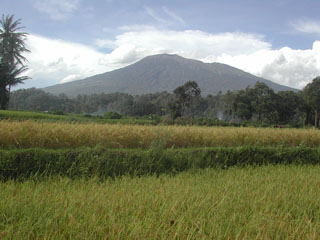Report on Marapi (Indonesia) — 26 June-2 July 2024
Smithsonian Institution / US Geological Survey
Weekly Volcanic Activity Report, 26 June-2 July 2024
Managing Editor: Sally Sennert.
Please cite this report as:
Global Volcanism Program, 2024. Report on Marapi (Indonesia) (Sennert, S, ed.). Weekly Volcanic Activity Report, 26 June-2 July 2024. Smithsonian Institution and US Geological Survey.
Marapi
Indonesia
0.38°S, 100.474°E; summit elev. 2885 m
All times are local (unless otherwise noted)
PVMBG reported that eruptive activity at Marapi (on Sumatra) was ongoing during 26 June-2 July. White gas-and-steam plumes rose as high as 300 m above the summit and drifted in multiple directions on 26 and 29 June and 2 July. Gray ash plumes rose 500 m above the summit and drifted SW on 28 June based on a Darwin VAAC report. Emissions were not observed on the other days. PVMBG noted that activity had generally declined during the previous two weeks. Seismic signals indicating eruptive events were at low levels, deformation data indicated deflation, and sulfur dioxide emissions were at low levels. At 1500 on 1 July the Alert Level was lowered to 2 (on a scale of 1-4), and the public was warned to stay 3 km away from the active crater.
Geological Summary. Gunung Marapi, not to be confused with the better-known Merapi volcano on Java, is Sumatra's most active volcano. This massive complex stratovolcano rises 2,000 m above the Bukittinggi Plain in the Padang Highlands. A broad summit contains multiple partially overlapping summit craters constructed within the small 1.4-km-wide Bancah caldera. The summit craters are located along an ENE-WSW line, with volcanism migrating to the west. More than 50 eruptions, typically consisting of small-to-moderate explosive activity, have been recorded since the end of the 18th century; no lava flows outside the summit craters have been reported in historical time.
Sources: Pusat Vulkanologi dan Mitigasi Bencana Geologi (PVMBG, also known as CVGHM), Darwin Volcanic Ash Advisory Centre (VAAC)

